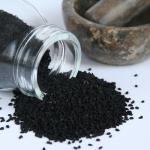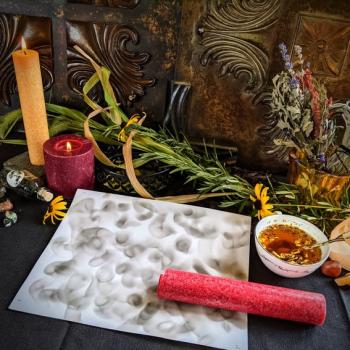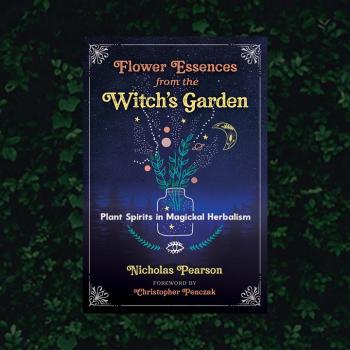Dark Fairy Herb of the Nocturnal Witch’s Garden
Datura, known by many names by many different cultures since ancient times, is one of the sisters of the Nightshade family; the Solanaceae. She has been used by European witches, native shaman of both North and South America, and is a popular plant of modern witches and sorcerers on the Poison Path. According to the lore of Scott Cunningham, Datura is used for hex breaking, sleep and protection, but that barely scratches the surface of this nocturnal witch’s herb. Like many of the plants of the Witch’s Garden, their mysteries continue to unfold as we work with their spirits and bodies in our practices.
This group of plants has many names and wears many masks, each name earning it a more sinister reputation. Jimsonweed, Thorn Apple, Devil’s Weed, Devil’s Trumpet and Witch’s Thimble are just a few of the folk name’s that it has gained over the centuries through its use in maleficia and visionary work. It is a dangerously poisonous plant that belongs to the group of baneful herbs, as mentioned in Plant Spirit Familiar by Christopher Penczak. Although its powerful chemical constituents have been utilized medicinally, like the other baneful herbs; there is a fine line between panaceae and poison.
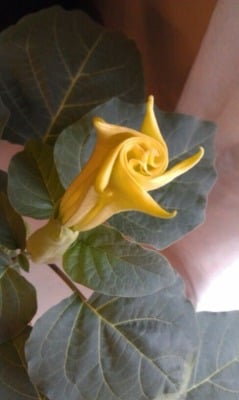
Seductive Visionary Herb of Shamanic Journeying
Datura is Belladonna’s seductive sister whose sweet-smelling and delicate flowers hypnotize and seduce those who are pulled close by her beauty. A closer look reveals her thorn-covered fruit hidden beneath dark green leaves and gossamer blooms. Once pulled in by her seductive wiles it is often too late, and her claws have dug deep into the unassuming psyche. Lulling her victims into a state of complacency whilst their sense of reality unravels around them, all the while wiping away any memory of her having been there in the first place. She whisks mortals off to the Otherworld, showing them both wonder and horror, returning them (hopefully) dazed and confused. She is not always so kind, and like the other tropane containing plants of the Nightshade family, which act on the delicate tissues of the heart she can easily kill and cause madness.
As a shamanistic tool, Datura has been used by many cultures to aid in divination and spirit flight, opening the gates to the Upper and Lower worlds. Other visionary plants allow us to peer through these gates, while remaining anchored to the physical plane, Datura grants freedom from those shackles sending the spirit on journeys both above and below.
Shamanic Uses:
This plant has been used by shaman and medicine men for thousands of years from one end of the world to the other. As an entheogen, a plant that allows one to connect to the divine, all parts of the plant have been utilized either topically in oils and ointments, smoking the seeds and leaves, or brewing them in visionary teas. A relative of this family is one of the ingredients in the infamously popular Ayahuasca ceremony of South American shamanism. When used recreationally without sacred ceremony and knowledge of how to approach and appease the plant spirit; it causes nightmares, invites unpleasant spirits and leads to death through cardiac arrest. It has been known to cause insanity and induce a catatonic state when used by the ignorant user seeking a high. This effect has also been exploited by criminals and the bokor, the feared evil sorcerers of Haitian voodoo. There are few in any true antidotes to the effects of Datura poisoning, although atropine has been used as an antidote for the effects of tropane alkaloids.
Other names this plant has been called are: Zombi, Devil’s Weed, Stinkweed, Prickly Bur, Hell’s Bells, Devil’s Cucumber, Jamestown weed, Moonflower, Mad Seeds, Loco weed, and Angel’s Trumpet.
Angel’s Trumpet is the Brugmansia variety, which has downward pointing flowers as if they were being played from the Heavens, while Devil’s Trumpet points up from below, playing her nefarious siren song to those with the ears to hear.
Datura was an important plant teacher to Carlos Castaneda, who describes its uses and spiritual properties in his often cited book, The Teachings of Don Juan, one of the most influential texts on modern shamanism.
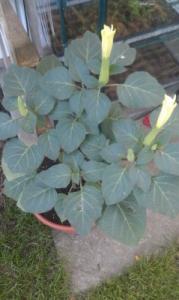
Witchcraft, Magic and Potion Making
The plants that have earned a place in the Witch’s Garden, the eternal Garden of Hecate, have done so due to their effective uses in sorcery. They are the witches and magicians of the plant world, and have proven their usefulness to those who walk the Crooked Way of magical herbalism. They are able to heal and harm, to give power and to take it away, and have willingly placed themselves in the path of the cunning one’s to act as guides. This plant, like her sisters, is intimately associated with magic and witchcraft, and the dark goddesses who were the first to journey to the depths of the Earth and return with arcane knowledge; or those who chose to stay making the Underworld their kingdoms.
The Nightshade family is often describe as a family of sisters, however with Datura I also see a masculine side to this plant. As a poisonous plant it is connected to Saturn, while its use in forceful love spells and manipulative aphrodisiacs come from its Venusian qualities, I can’t help but sense an undertone of fiery Mars. This martial quality can be seen in its thorn-covered apples, and through its uses in destructive spells of magical warfare. I’m starting to wonder if many plants of the Witch’s Garden, contain layers of all the celestial influences. This makes it difficult to categorize them under one specific planetary influence.
Some of the magical applications for this plant are:
psychic enhancement through vision and spirit voices
dream magic both sending and receiving, creating enchanting illusions and terrible nightmares which offers a number of creative and manipulative purposes
manipulative and forceful love spells, inspiring lust and desire
nocturnal allies, like the owl, moth and insects-honoring the spirits of the night and the moon
connecting with the darker aspects of the Witch Queen, and Fairy realm, especially those fae most active at night.
spells of manipulation, hypnosis, and submission
Other resources and references:
Castaneda, Carlos. The Teachings of Don Juan
Grimassi, Raven. Grimoire of the Thorn-blooded Witch.
Penczak, Christopher. The Plant Spirit Familiar.
Pendell, Dale. Pharmako Gnosis: Plant Teachers and the Poison Path.
Ratsch, Christian and Claudia Muller-Ebeling. Witchcraft Medicine.
Ratsch, Christian. The Encyclopedia of Psychoactive Plants.
Roth, Harold. Datura stramonium, Alchemy Works.
Ward, Coby Michael. Devil’s Breath: A Trick of the Nightshades
Ward, Coby Michael. The Poisoner’s Pocket Guide.
Ward, Coby Michael. Poisoner’s Apothecary on Tumblr

